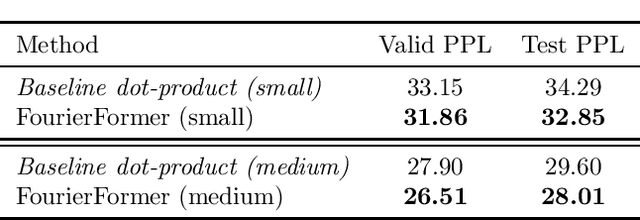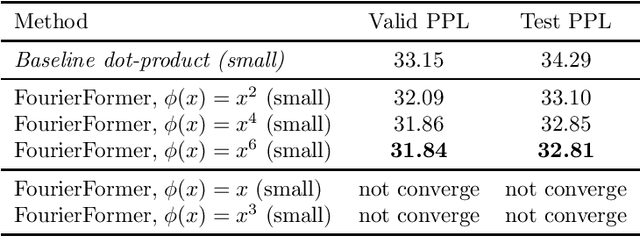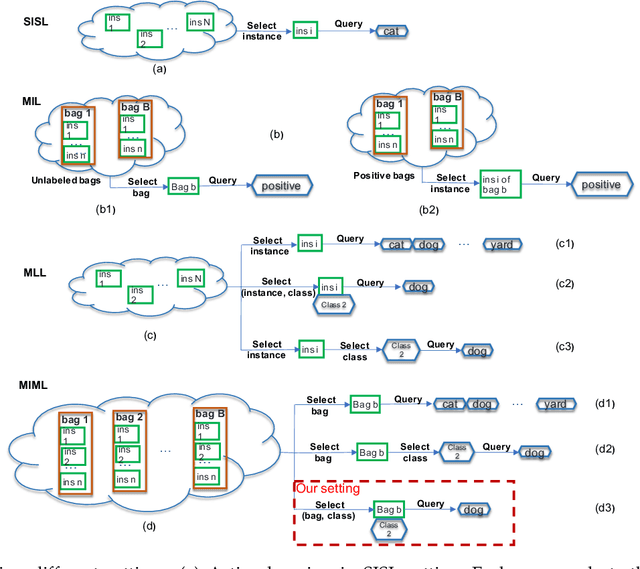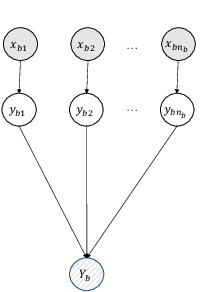Tam Nguyen
Improving Routing in Sparse Mixture of Experts with Graph of Tokens
May 01, 2025Abstract:Sparse Mixture of Experts (SMoE) has emerged as a key to achieving unprecedented scalability in deep learning. By activating only a small subset of parameters per sample, SMoE achieves an exponential increase in parameter counts while maintaining a constant computational overhead. However, SMoE models are susceptible to routing fluctuations--changes in the routing of a given input to its target expert--at the late stage of model training, leading to model non-robustness. In this work, we unveil the limitation of SMoE through the perspective of the probabilistic graphical model (PGM). Through this PGM framework, we highlight the independence in the expert-selection of tokens, which exposes the model to routing fluctuation and non-robustness. Alleviating this independence, we propose the novel Similarity-Aware (S)MoE, which considers interactions between tokens during expert selection. We then derive a new PGM underlying an (S)MoE-Attention block, going beyond just a single (S)MoE layer. Leveraging the token similarities captured by the attention matrix, we propose the innovative Attention-Aware (S)MoE, which employs the attention matrix to guide the routing of tokens to appropriate experts in (S)MoE. We theoretically prove that Similarity/Attention-Aware routing help reduce the entropy of expert selection, resulting in more stable token routing mechanisms. We empirically validate our models on various tasks and domains, showing significant improvements in reducing routing fluctuations, enhancing accuracy, and increasing model robustness over the baseline MoE-Transformer with token routing via softmax gating.
A Primal-Dual Framework for Transformers and Neural Networks
Jun 19, 2024Abstract:Self-attention is key to the remarkable success of transformers in sequence modeling tasks including many applications in natural language processing and computer vision. Like neural network layers, these attention mechanisms are often developed by heuristics and experience. To provide a principled framework for constructing attention layers in transformers, we show that the self-attention corresponds to the support vector expansion derived from a support vector regression problem, whose primal formulation has the form of a neural network layer. Using our framework, we derive popular attention layers used in practice and propose two new attentions: 1) the Batch Normalized Attention (Attention-BN) derived from the batch normalization layer and 2) the Attention with Scaled Head (Attention-SH) derived from using less training data to fit the SVR model. We empirically demonstrate the advantages of the Attention-BN and Attention-SH in reducing head redundancy, increasing the model's accuracy, and improving the model's efficiency in a variety of practical applications including image and time-series classification.
PIDformer: Transformer Meets Control Theory
Feb 25, 2024



Abstract:In this work, we address two main shortcomings of transformer architectures: input corruption and rank collapse in their output representation. We unveil self-attention as an autonomous state-space model that inherently promotes smoothness in its solutions, leading to lower-rank outputs and diminished representation capacity. Moreover, the steady-state solution of the model is sensitive to input perturbations. We incorporate a Proportional-Integral-Derivative (PID) closed-loop feedback control system with a reference point into the model to improve robustness and representation capacity. This integration aims to preserve high-frequency details while bolstering model stability, rendering it more noise-resilient. The resulting controlled state-space model is theoretically proven robust and adept at addressing the rank collapse. Motivated by this control framework, we derive a novel class of transformers, PID-controlled Transformer (PIDformer), aimed at improving robustness and mitigating the rank-collapse issue inherent in softmax transformers. We empirically evaluate the model for advantages and robustness against baseline transformers across various practical tasks, including object classification, image segmentation, and language modeling.
Mitigating Over-smoothing in Transformers via Regularized Nonlocal Functionals
Dec 01, 2023



Abstract:Transformers have achieved remarkable success in a wide range of natural language processing and computer vision applications. However, the representation capacity of a deep transformer model is degraded due to the over-smoothing issue in which the token representations become identical when the model's depth grows. In this work, we show that self-attention layers in transformers minimize a functional which promotes smoothness, thereby causing token uniformity. We then propose a novel regularizer that penalizes the norm of the difference between the smooth output tokens from self-attention and the input tokens to preserve the fidelity of the tokens. Minimizing the resulting regularized energy functional, we derive the Neural Transformer with a Regularized Nonlocal Functional (NeuTRENO), a novel class of transformer models that can mitigate the over-smoothing issue. We empirically demonstrate the advantages of NeuTRENO over the baseline transformers and state-of-the-art methods in reducing the over-smoothing of token representations on various practical tasks, including object classification, image segmentation, and language modeling.
p-Laplacian Transformer
Nov 06, 2023
Abstract:$p$-Laplacian regularization, rooted in graph and image signal processing, introduces a parameter $p$ to control the regularization effect on these data. Smaller values of $p$ promote sparsity and interpretability, while larger values encourage smoother solutions. In this paper, we first show that the self-attention mechanism obtains the minimal Laplacian regularization ($p=2$) and encourages the smoothness in the architecture. However, the smoothness is not suitable for the heterophilic structure of self-attention in transformers where attention weights between tokens that are in close proximity and non-close ones are assigned indistinguishably. From that insight, we then propose a novel class of transformers, namely the $p$-Laplacian Transformer (p-LaT), which leverages $p$-Laplacian regularization framework to harness the heterophilic features within self-attention layers. In particular, low $p$ values will effectively assign higher attention weights to tokens that are in close proximity to the current token being processed. We empirically demonstrate the advantages of p-LaT over the baseline transformers on a wide range of benchmark datasets.
Transformer with Fourier Integral Attentions
Jun 01, 2022



Abstract:Multi-head attention empowers the recent success of transformers, the state-of-the-art models that have achieved remarkable success in sequence modeling and beyond. These attention mechanisms compute the pairwise dot products between the queries and keys, which results from the use of unnormalized Gaussian kernels with the assumption that the queries follow a mixture of Gaussian distribution. There is no guarantee that this assumption is valid in practice. In response, we first interpret attention in transformers as a nonparametric kernel regression. We then propose the FourierFormer, a new class of transformers in which the dot-product kernels are replaced by the novel generalized Fourier integral kernels. Different from the dot-product kernels, where we need to choose a good covariance matrix to capture the dependency of the features of data, the generalized Fourier integral kernels can automatically capture such dependency and remove the need to tune the covariance matrix. We theoretically prove that our proposed Fourier integral kernels can efficiently approximate any key and query distributions. Compared to the conventional transformers with dot-product attention, FourierFormers attain better accuracy and reduce the redundancy between attention heads. We empirically corroborate the advantages of FourierFormers over the baseline transformers in a variety of practical applications including language modeling and image classification.
Transformer with a Mixture of Gaussian Keys
Oct 16, 2021



Abstract:Multi-head attention is a driving force behind state-of-the-art transformers which achieve remarkable performance across a variety of natural language processing (NLP) and computer vision tasks. It has been observed that for many applications, those attention heads learn redundant embedding, and most of them can be removed without degrading the performance of the model. Inspired by this observation, we propose Transformer with a Mixture of Gaussian Keys (Transformer-MGK), a novel transformer architecture that replaces redundant heads in transformers with a mixture of keys at each head. These mixtures of keys follow a Gaussian mixture model and allow each attention head to focus on different parts of the input sequence efficiently. Compared to its conventional transformer counterpart, Transformer-MGK accelerates training and inference, has fewer parameters, and requires less FLOPs to compute while achieving comparable or better accuracy across tasks. Transformer-MGK can also be easily extended to use with linear attentions. We empirically demonstrate the advantage of Transformer-MGK in a range of practical applications including language modeling and tasks that involve very long sequences. On the Wikitext-103 and Long Range Arena benchmark, Transformer-MGKs with 4 heads attain comparable or better performance to the baseline transformers with 8 heads.
Active Learning in Incomplete Label Multiple Instance Multiple Label Learning
Jul 26, 2021



Abstract:In multiple instance multiple label learning, each sample, a bag, consists of multiple instances. To alleviate labeling complexity, each sample is associated with a set of bag-level labels leaving instances within the bag unlabeled. This setting is more convenient and natural for representing complicated objects, which have multiple semantic meanings. Compared to single instance labeling, this approach allows for labeling larger datasets at an equivalent labeling cost. However, for sufficiently large datasets, labeling all bags may become prohibitively costly. Active learning uses an iterative labeling and retraining approach aiming to provide reasonable classification performance using a small number of labeled samples. To our knowledge, only a few works in the area of active learning in the MIML setting are available. These approaches can provide practical solutions to reduce labeling cost but their efficacy remains unclear. In this paper, we propose a novel bag-class pair based approach for active learning in the MIML setting. Due to the partial availability of bag-level labels, we focus on the incomplete-label MIML setting for the proposed active learning approach. Our approach is based on a discriminative graphical model with efficient and exact inference. For the query process, we adapt active learning criteria to the novel bag-class pair selection strategy. Additionally, we introduce an online stochastic gradient descent algorithm to provide an efficient model update after each query. Numerical experiments on benchmark datasets illustrate the robustness of the proposed approach.
A Passivity-Based Distributed Reference Governor for Constrained Robotic Networks
Mar 19, 2017



Abstract:This paper focuses on a passivity-based distributed reference governor (RG) applied to a pre-stabilized mobile robotic network. The novelty of this paper lies in the method used to solve the RG problem, where a passivity-based distributed optimization scheme is proposed. In particular, the gradient descent method minimizes the global objective function while the dual ascent method maximizes the Hamiltonian. To make the agents converge to the agreed optimal solution, a proportional-integral consensus estimator is used. This paper proves the convergence of the state estimates of the RG to the optimal solution through passivity arguments, considering the physical system static. Then, the effectiveness of the scheme considering the dynamics of the physical system is demonstrated through simulations and experiments.
 Add to Chrome
Add to Chrome Add to Firefox
Add to Firefox Add to Edge
Add to Edge